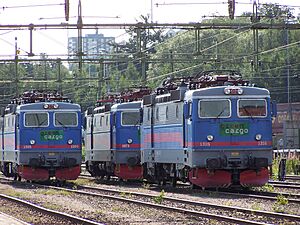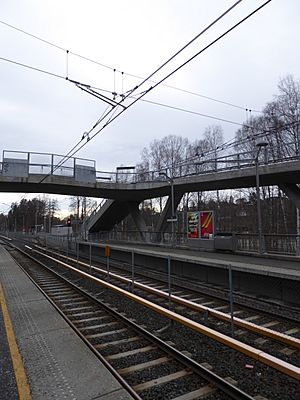Railway electrification system facts for kids
A railway electrification system is a special way to give trains power using electricity. It helps locomotives (the engines that pull trains) and multiple units (trains made of several connected cars) move without needing their own engine that burns fuel.
Using electricity for trains has some cool benefits! It's very good at saving energy, which means it's efficient, and it costs less to run the trains every day. However, setting up all the wires and other equipment, called infrastructure, can be quite expensive at the start.
Contents
How Trains Get Power
Trains can get electricity in different ways, and what system is used often depends on the country. The most common ways to power electric trains are:
Overhead Wires
Many trains get their power from wires that hang above the tracks. These are called overhead lines or catenary wires. A special arm on top of the train, called a pantograph, touches these wires to collect the electricity.
There are two main types of electricity used with overhead wires:
- Alternating Current (AC): This is a type of electricity where the flow changes direction many times a second.
- Direct Current (DC): This is a type of electricity where the flow goes in only one direction.
- Some overhead systems use 1,500 or 3,000 volts. You can find these in places like Japan, Australia, and parts of Europe.
Third Rail Systems
Another way trains get power is from a special rail placed next to the main tracks. This is called a third rail. A metal shoe on the side of the train slides along this rail to pick up the electricity.
Third rail systems usually use direct current (DC) at lower voltages:
- 600 or 750 volts. This is often used for subway trains and some commuter lines, especially in cities like London and New York.
Why Different Systems?
The choice of system depends on many things, like how old the railway is, how fast the trains need to go, and how much power they need. Higher voltages (like 25,000 volts AC) are good for long distances and high-speed trains because they lose less power over distance. Lower voltages (like 750 volts DC) are often used in busy city areas or underground tunnels because they are simpler to set up and can be safer in tight spaces.
Advantages of Electric Trains
Electric trains are great for several reasons:
- Cleaner Air: They don't produce exhaust fumes like diesel trains, which helps keep the air cleaner.
- Quieter: Electric trains are generally much quieter than diesel trains, which is good for people living near railway lines.
- Faster and More Powerful: Electric motors can be very powerful, allowing trains to accelerate quickly and reach high speeds.
- Energy Efficient: They use energy more efficiently, which means less energy is wasted.
- Lower Running Costs: While setting up the system is expensive, the daily cost of electricity can be cheaper than fuel.
Challenges of Electrification
Even with all the benefits, electrifying a railway has its challenges:
- High Initial Cost: Installing all the wires, power stations, and other equipment is very expensive.
- Clearance Issues: Sometimes, old bridges or tunnels aren't tall enough for the overhead wires, and they need to be rebuilt or modified.
- Safety: High voltage electricity is dangerous, so strict safety rules and equipment are needed.
Related pages
Images for kids
-
An old Metro-Cammell train on the Kowloon-Canton Railway in Hong Kong in 1993. This is Hong Kong's oldest railway, started in 1910.
-
This shows where a train can switch from getting power from a third rail to overhead wires on Chicago's Yellow Line.
-
An early building that helped power electric trains in Dartford, England.
-
A tram in Nottingham Express Transit in the UK uses a 750 V DC overhead wire, like many modern tram systems.
-
London Underground tracks at Ealing Common showing the third and fourth rails used for power.
-
The bogie (wheel assembly) from an MP 89 Paris Métro train. You can see the contact shoe between the rubber tires.
-
Lots Road Power Station in a poster from 1910. This power station helped power London's trains and trams.
-
The Royal Border Bridge in England. Adding electric wires to old bridges like this can be very expensive.
See also
 In Spanish: Sistema de electrificación ferroviaria para niños
In Spanish: Sistema de electrificación ferroviaria para niños

















